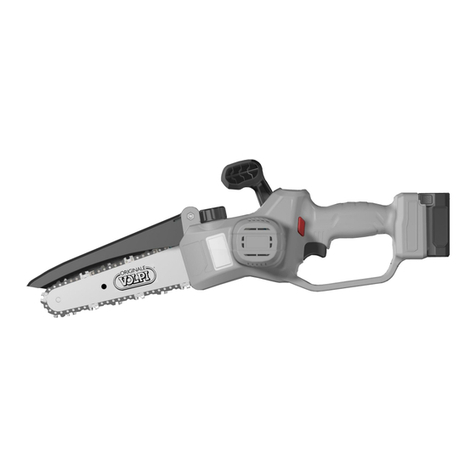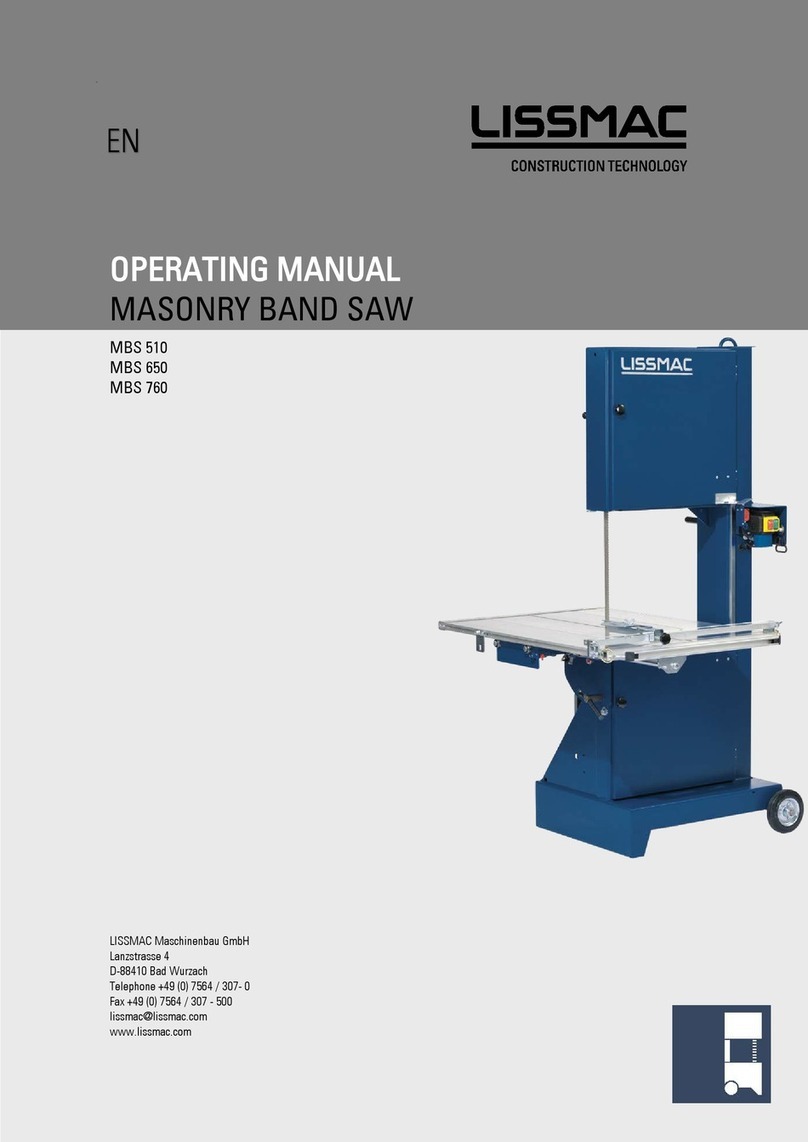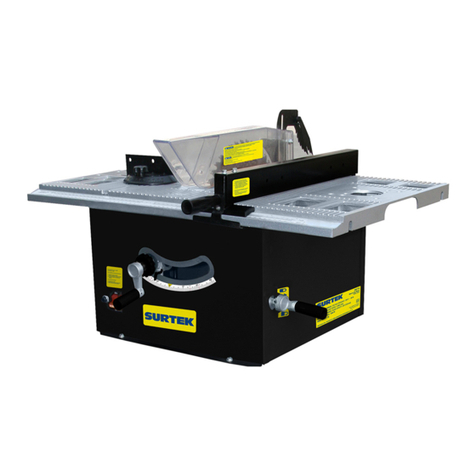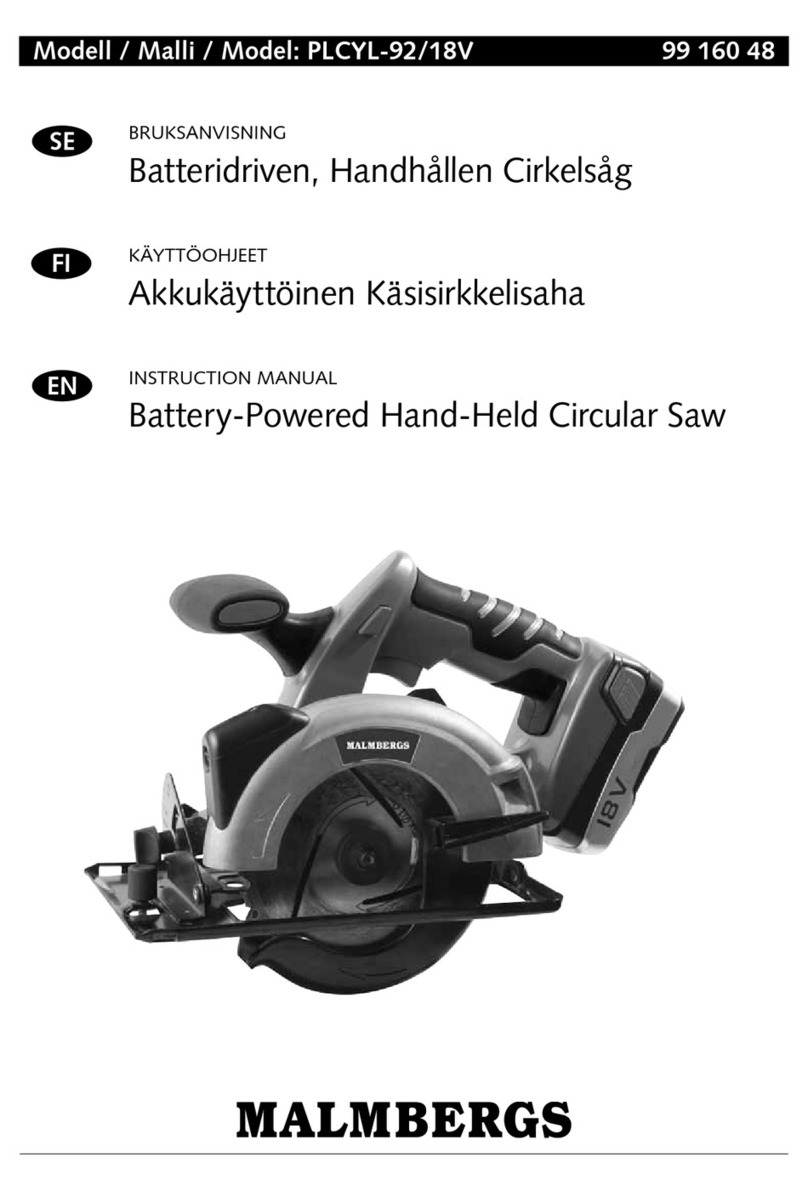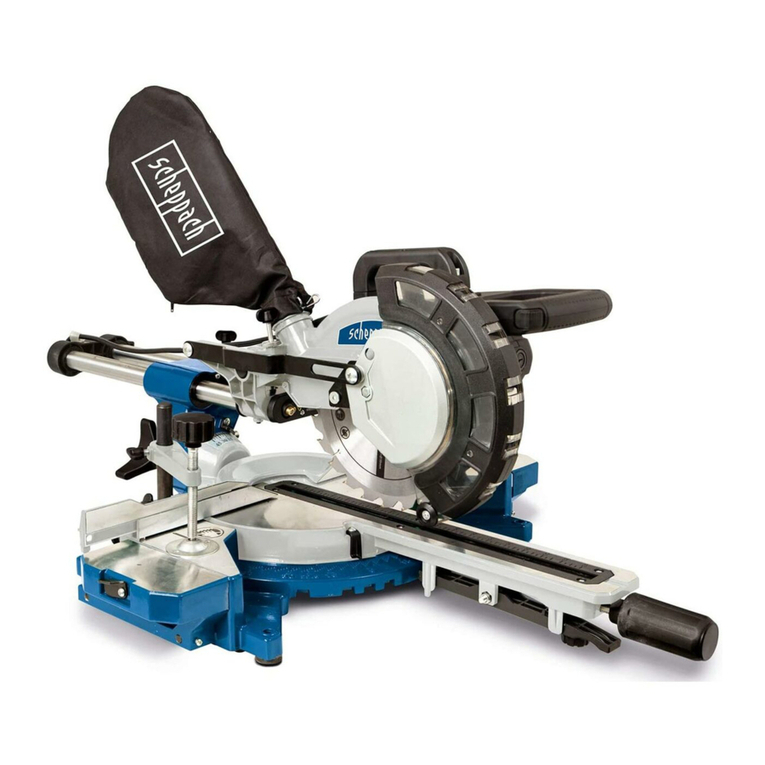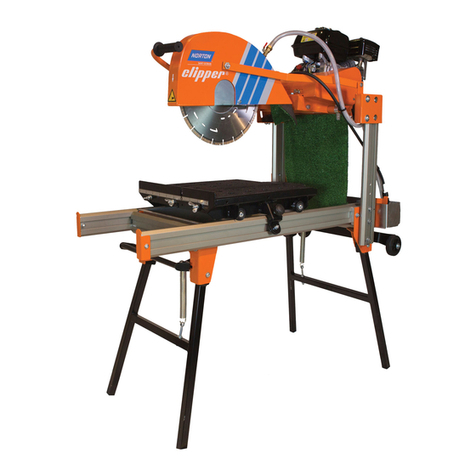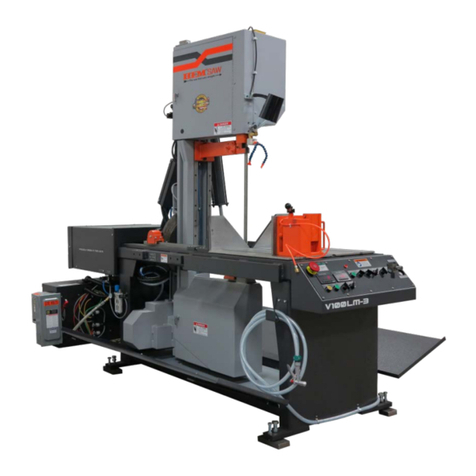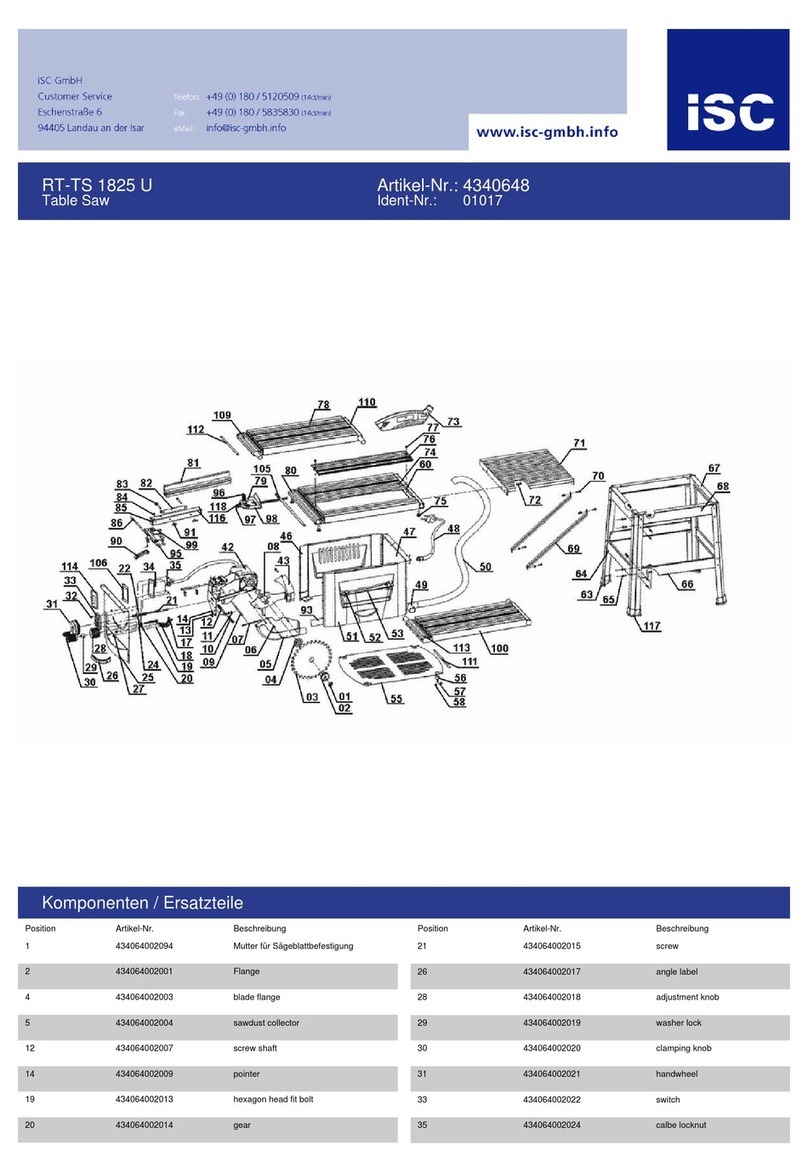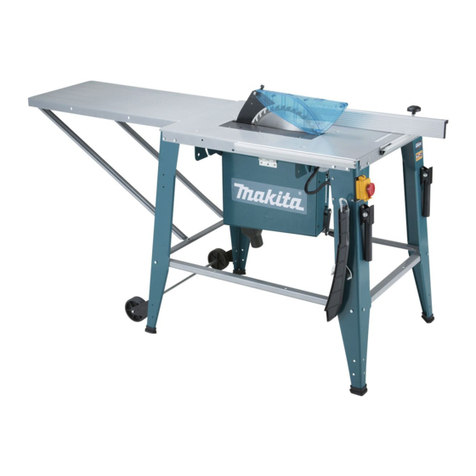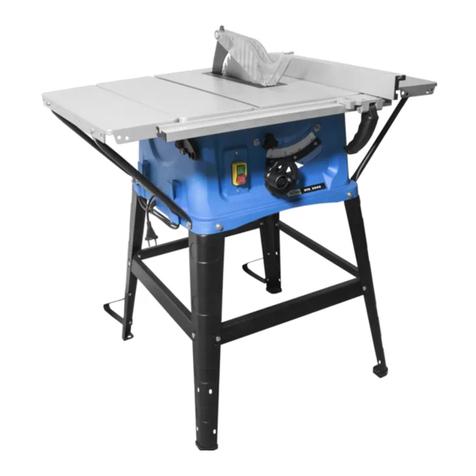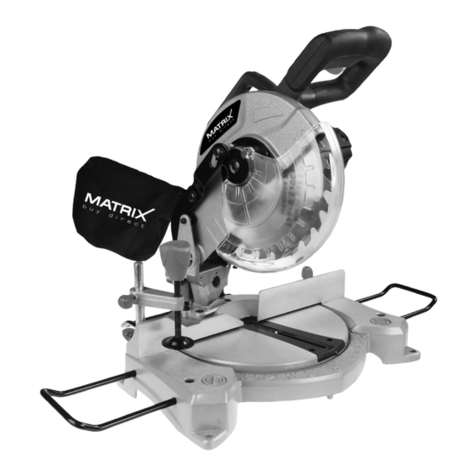Automatic CS184-A User manual

1500W
184mm (7 1/4”)
Circular Saw
INSTRUCTION MANUAL
CS184-A

2
Warranty 2
Introduction 3
Environmental protection 3
Description of symbols 3
Specifications 3
General safety rules 4
Additional safety rules for circular saws 6
Accessories 7
Unpacking 7
Assembly 7
Know your product 8
Overview 9
Adjusting the cutting depth 9
Adjusting the bevel angle 9
Switching on and off 10
Making a cut 10
Making a pocket cut 11
Using the parallel fence 11
Changing the blade 12
Maintenance 13
Cleaning 13
General inspection 13
Power cord maintenance 13
Troubleshooting 13
Contents
Warranty Power Tools
1 Year Repair Warranty.
Register your warranty at www.automatictools.com.au
All warranty conditions can be found on the
www.automatictools.com.au website or email

3
Regulatory Compliance Mark. Appliance
complies with requirements of electrical
approval & EMC in Australia
Do not throw the electronic waste products into
the domestic waste refuse. Such products must be
delivered to a recycling centre.
Specifications
Model # CS184-A
Voltage: 230 – 240V ~ 50 Hz
Power rating: 1500W
No load speed: 5500 min-1
Blade diameter: 184mm
Blade teeth: 24 TCT
Blade arbour: 16mm
Blade kerf: 2.5mm
Bevel capacity: 0° to 45°
Depth of cut at 90°: 66mm
Depth of cut at 45°: 45mm
Electrical insulation: Double insulated
Weight: 4.0kg
This tool is double insulated. There are two independent
barriers of insulation to protect you from the possibility of
electric shock.
The sound intensity level for the operator may exceed
85dB(A) and sound protection measures are necessary.
Description of symbols
The rating plate on your tool may show symbols.
These represent important information about the
product or instructions on its use.
Wear hearing protection.
Wear eye protection.
Wear breathing protection.
For safe operation read instruction manual.
Double insulated for additional protection.
Conforms to relevant standards
for electromagnetic compatibility.
Introduction
Your new AUTOMATIC power tool will more than satisfy
your expectations. It has been manufactured under
stringent AUTOMATIC Quality Standards to meet
superior performance criteria.
You will find your new tool easy and safe to operate,
and, with proper care, it will give you many years
of dependable service.
CAUTION. Carefully read through this entire Instruction
Manual before using your new AUTOMATIC Power Tool.
Take special care to heed the Cautions and Warnings.
Your AUTOMATIC power tool has many features that
will make your job faster and easier. Safety, performance,
and dependability have been given top priority in the
development of this tool, making it easy to maintain
and operate.
Environmental protection
Recycle unwanted materials instead
of disposing of them as waste. All tools,
hoses and packaging should be sorted,
taken to the local recycling centre and
disposed of in an environmentally safe way.

4
General safety rules
WARNING. Read all safety warnings and all instructions.
Failure to follow the warnings and instructions may result in
electric shock, fire and/or serious injury.
Save all warnings and instructions for future reference.
The term “power tool” in the warnings refers to your mains-
operated (corded) power tool or battery-operated (cordless)
power tool.
1) Work area safety
a) Keep work area clean and well lit. Cluttered or dark
areas invite accidents.
b) Do not operate power tools in explosive atmospheres,
such as in the presence of flammable liquids, gases
or dust. Power tools create sparks which may ignite the
dust or fumes.
c) Keep children and bystanders away while operating a
power tool. Distractions can cause you to lose control.
2) Electrical safety
a) Power tool plugs must match the outlet. Never modify
the plug in any way. Do not use any adapter plugs
with earthed (grounded) power tools. Unmodified plugs
and matching outlets will reduce risk of electric shock.
b) Avoid body contact with earthed or grounded
surfaces, such as pipes, radiators, ranges and
refrigerators. There is an increased risk of electric
shock if your body is earthed or grounded.
c) Do not expose power tools to rain or wet conditions.
Water entering a power tool will increase the risk of
electric shock.
d) Do not abuse the cord. Never use the cord for
carrying, pulling or unplugging the power tool.
Keep cord away from heat, oil, sharp edges or moving
parts. Damaged or entangled cords increase
the risk of electric shock.
e) When operating a power tool outdoors, use an
extension cord suitable for outdoor use. Use of a cord
suitable for outdoor use reduces the risk of electric shock.
f) To reduce the risk of electric shock, the manufacturer
recommends the use of a residual current device
with a rated residual current of 30mA or less at
all times.
3) Personal safety
a) Stay alert, watch what you are doing and use
common sense when operating a power tool. Do not
use a power tool while you are tired or under the
influence of drugs, alcohol or medication. A moment
of inattention while operating power tools may result in
serious personal injury.
b) Use personal protective equipment. Always wear eye
protection. Protective equipment such as dust mask,
non-skid safety shoes, hard hat, or hearing protection used
for appropriate conditions will reduce personal injuries.
c) Prevent unintentional starting. Ensure the switch
is in the off-position before connecting to power
source and/or battery pack, picking up or carrying
the tool. Carrying power tools with your finger on the
switch or energising power tools that have the switch
on invites accidents.
d) Remove any adjusting key or wrench before
turning the power tool on. A wrench or a key left
attached to a rotating part of the power tool may result
in personal injury.
e) Do not overreach. Keep proper footing and balance
at all times. This enables better control of the power tool
in unexpected situations.
f ) Dress properly. Do not wear loose clothing or
jewellery. Keep your hair, clothing and gloves away
from moving parts. Loose clothes, jewellery or long hair
can be caught in moving parts.
g) If devices are provided for the connection of dust
extraction and collection facilities, ensure these are
connected and properly used. Use of dust collection
can reduce dust-related hazards.

5
4) Power tool use and care
a) Do not force the power tool. Use the correct power
tool for your application. The correct power tool will
do the job better and safer at the rate for which it was
designed.
b) Do not use the power tool if the switch does not turn
it on and off. Any power tool that cannot be controlled
with the switch is dangerous and must be repaired.
c) Disconnect the plug from the power source and/or
the battery pack from the power tool before making
any adjustments, changing accessories, or storing
power tools. Such preventive safety measures reduce
the risk of starting the power tool accidentally.
d) Store idle power tools out of the reach of children
and do not allow persons unfamiliar with the power
tool or these instructions to operate the power tool.
Power tools are dangerous in the hands of untrained users.
e) Maintain power tools. Check for misalignment or
binding of moving parts, breakage of parts and any
other condition that may affect the power tool’s
operation. If damaged, have the power tool repaired
before use. Many accidents are caused by poorly
maintained power tools.
f ) Keep cutting tools sharp and clean. Properly
maintained cutting tools with sharp cutting edges are
less likely to bind and are easier to control.
g) Use the power tool, accessories and tool bits etc.
in accordance with these instructions, taking into
account the working conditions and the work to be
performed. Use of the power tool for operations different
from those intended could result in a hazardous situation.
h) This appliance is not intended for use by persons
(including children) with reduced physical, sensory
or mental capabilities, or lack of experience and
knowledge, unless they have been given supervision or
instruction concerning use of the appliance by a person
responsible for their safety.
i) Children should be supervised to ensure that they do
not play with the appliance.
5) Service
a) Have your power tool serviced by a qualified repair
person using only identical replacement parts.
This will ensure that the safety of the power tool is
maintained.
CAUTION. Use of controls or adjustments or performance
of procedures other than those specified herein may result
in hazardous radiation exposure.
Additional safety rules for circular saws
WARNING! The warnings, precautions, and instructions
discussed in this manual cannot cover all possible
conditions and situations that may occur. The operator must
understand that common sense and caution are factors
which cannot be built into this product, but must be supplied
by the operator.
DANGER
a. Keep hands away from cutting area and the blade.
Keep your second hand on auxiliary handle, or motor
housing. If both hands are holding the saw, they cannot
be cut by the blade.
b. Do not reach underneath the workpiece. The guard
cannot protect you from the blade below the workpiece.
c. Adjust the cutting depth to the thickness of the
workpiece. Less than a full tooth of the blade teeth
should be visible below the workpiece.
d. Never hold piece being cut in your hands or across
your leg. Secure the workpiece to a stable platform.
It is important to support the work properly to minimize
body exposure, blade binding, or loss of control.
e. Hold power tool by insulated gripping surfaces when
performing an operation where the cutting tool may
contact hidden wiring or its own cord. Contact with
a “live” wire will also make exposed metal parts of the
power tool “live” and shock the operator.

6
f. When ripping always use a rip fence or straight edge
guide. This improves the accuracy of cut and reduces
the chance of blade binding.
g. Always use blades with correct size and shape
(diamond versus round) of arbour holes. Blades that
do not match the mounting hardware of the saw will run
eccentrically, causing loss of control.
h. Never use damaged or incorrect blade washers or
bolt. The blade washers and bolt were specially designed
for your saw, for optimum performance and safety of
operation.
Causes and operator prevention of kickback:
• Kickbackisasuddenreactiontoapinched,boundor
misaligned saw blade, causing an uncontrolled saw to lift
up and out of the workpiece toward the operator;
• Whenthebladeispinchedorboundtightlybythekerf
closing down, the blade stalls and the motor reaction
drives the unit rapidly back toward the operator;
• Ifthebladebecomestwistedormisalignedinthecut,the
teeth at the back edge of the blade can dig into the top
surface of the wood causing the blade to climb out of the
kerf and jump back toward the operator.
Kickbackistheresultofsawmisuseand/orincorrect
operating procedures or conditions and can be avoided by
taking proper precautions as given below.
a. Maintain a firm grip with both hands on the saw and
position your arms to resist kickback forces. Position
your body to either side of the blade, but not in line
with the blade.Kickbackcouldcausethesawtojump
backwards, but kickback forces can be controlled by the
operator, if proper precautions are taken.
b. When blade is binding, or when interrupting a cut
for any reason, release the trigger and hold the saw
motionless in the material until the blade comes to a
complete stop. Never attempt to remove the saw from
the work or pull the saw backward while the blade is
in motion or kickback may occur. Investigate and take
corrective actions to eliminate the cause of blade binding.
c. When restarting a saw in the workpiece, centre the
saw blade in the kerf and check that saw teeth are
not engaged into the material. If saw blade is binding, it
may walk up or kickback from the workpiece as the saw
is restarted.
d. Support large panels to minimise the risk of blade
pinching and kickback. Large panels tend to sag under
their own weight. Supports must be placed under the
panel on both sides, near the line of cut and near the
edge of the panel.
e. Do not use dull or damaged blades. Unsharpened
or improperly set blades produce narrow kerf causing
excessive friction, blade binding and kickback.
f. Blade depth and bevel adjusting locking levers
must be tight and secure before making cut. If blade
adjustment shifts while cutting, it may cause binding and
kickback.
g. Use extra caution when making a “plunge cut” into
existing walls or other blind areas. The protruding
blade may cut objects that can cause kickback.
The protruding blade may cut objects that can
cause kickback.
a. Check lower guard for proper closing before each
use. Do not operate the saw if lower guard does
not move freely and close instantly. Never clamp or
tie the lower guard into the open position. If saw is
accidentally dropped, lower guard may be bent. Raise the
lower guard with the retracting handle and make sure it
moves freely and does not touch the blade or any other
part, in all angles and depths of cut.
b. Check the operation of the lower guard spring. If the
guard and the spring are not operating properly, they
must be serviced before use. Lower guard may operate
sluggishly due to damaged parts, gummy deposits, or a
build-up of debris.

7
c. Lower guard should be retracted manually only for
special cuts such as “plunge cuts” and “compound
cuts.” Raise lower guard by retracting handle and as
soon as blade enters the material, the lower guard
must be released. For all other sawing, the lower guard
should operate automatically.
d. Always observe that the lower guard is covering the
blade before placing saw down on bench or floor. An
unprotected, coasting blade will cause the saw to walk
backwards, cutting whatever is in its path.
Be aware of the time it takes for the blade to stop after
switch is released.
e. Do not use abrasive wheels
WARNING. We recommend the use of a residual current
device with a residual current rating of 30mA or less.
Wear goggles
Wear earmuffs
Wear a breathing mask
Accessories
The Automatic Circular saw is supplied with the following
accessories as standard:
1. 184 mm (7 1/4”) TCT Blade (fitted)
2. Blade Wrench
3. Parallel Fence
4. Instruction manual
Unpacking
Due to modern mass production techniques, it is unlikely
that your Automatic Power Tool is faulty or that a part is
missing. If you find anything wrong, do not operate the tool
until the parts have been replaced or the fault has been
rectified. Failure to do so could result in serious personal
injury.
Assembly
The Automatic circular saw is packed fully assembled,
except for the Parallel Fence which will need to be attached.

8
Know your product
1. On/Off Trigger switch
2. Lock-off button
3. Motor housing
4. Main handle
5. Front handle
6. Bevel adjustment knob
7. Bevel scale
8. Parallel fence
locking wingnut
9. Parallel fence
10. Blade guard lever
11. Lower blade guard
12. Base plate
13. Upper blade guard
14. Dust extraction port
15. Depth locking knob
16. Depth of cut indicator
17. Spindle lock button
18. Blade
19. Blade Wrench
20. Blade guide notch
21. Parallel fence slots
22. Blade rotation indicator
23. Outer flange
24.
Inner flange (not visible)
25. Blade bolt
11
7
5
21
20
17
18
25
10
13
14
19
3
15
4
16
1
2
9
5
22
23
12
21
8
6

9
Overview
You have purchased an Automatic Circular Saw.
Please refer to the safety instructions given earlier in this
manual for important instructions.
The saw is capable of ripping and cross cutting hardwoods,
softwoods and man made boards quickly, accurately and safely.
By loosening the bevel adjustment knob, the body and the
blade of the saw can be tilted to any angle up to 45° for
making angle cuts. Please note that the maximum depth of
cut is reduced when cutting at an angle.
The fixed upper blade guard encloses the upper part of the
blade. As the saw advances through the work piece,
the pivoting lower blade guard is pushed back by the edge
of the wood to expose only that part of the blade which is
needed. When the blade clears the work, the spring loaded
lower blade guard snaps back to completely enclose the blade.
Adjusting the cutting depth
CAUTION. Always ensure that the saw is switched off
and unplugged from the power supply before making
any adjustments.
1. Ensure that the saw is facing away from you.
2. Loosen the Depth Locking knob (15).
3.
Hold the base plate flat against the edge of the work piece
and lift the body of the saw until the blade is at the right
depth (Fig. B). Use the depth of cut indicator to determine
the approximate cutting depth the cutting depth.
4. Tighten the Depth Locking knob (15).
Note. Always use the correct blade depth setting.
The correct blade depth setting for all cuts should not be
more than (6.35mm) 1/4” below the material being cut.
Allowing more depth will increase the chance of kickback
and result in a rough cut.
Adjusting the bevel angle
CAUTION. Always ensure that the saw is switched off
and unplugged from the power supply before making
any adjustments.
1. The saw can be adjusted to cut at any angle between
0° and 45°. When making 45° bevel cuts, there is a
notch in the saw base to help you line up the blade with
the line of cut. Align your line of cut with the inner blade
guide notch on the base of the saw when making 45°
bevel cuts.
2. Loosen the bevel adjustment knob (6) located at the front
of the base plate (Fig. C).
3. Tilt the body of the saw until the required angle is
reached (Fig. D) using the bevel scale as a guide.
4. Tighten the bevel
adjustment knob (6) to secure
the base plate (Fig. E).
B
A
D
C
E

10
Note. Always make a trial cut in a scrap piece of material
along a guideline to determine how much you should offset
the blade from the guideline to make an accurate cut.
Switching on and off
1. Connect the plug to the power supply.
2. To turn on, depress the lock-off button (Fig. F) and
squeeze the On/Off trigger switch (Fig. G).
3. The blade will take approximately 2 seconds to reach
full speed.
4. To Turn OFF, release the On/Off trigger switch, the
machine turns off and the lock-off button re-engages to
prevent accidental operation.
CAUTION. Allow the blade to come to a complete standstill
before setting the saw down.
Making a cut
1. Mark the line of cut on the
work piece.
2. Adjust the depth of cut and
bevel angle as required.
3. When making 90° cross or rip
cuts, align your line of cut with
the outer blade guide notch on
the base of the saw (Fig. Ha).
4. When making 45° bevel cuts,
align your line of cut with the
inner blade guide notch on the
base of the saw. (Fig. Hb).
5. Rest the front edge of the
base on the work piece
(Fig. I).
6. Start the motor by depressing
the lock-off button and
squeezing the On/Off trigger
switch.
Note. Always let the blade reach
full speed (approximately
2 seconds) before you begin
to cut into the work piece.
7. Slowly push the saw forward
using both hands (Fig. J).
8. When making a cut always
use steady, even pressure.
Forcing the saw causes rough
cuts and could shorten the life
of the saw or cause kickback.
Allow the blade and the saw
to do the work.
9. After completing your cut, release the trigger switch
and allow the blade to come to a complete stop.
Do not remove the saw from the work piece while
the blade is moving.
Note. Since blade thickness varies, always make a trial
cut in scrap material along the guideline to determine how
much, if any, the guideline must be offset to get an
accurate cut for the job being performed.
G
F
Ha
I
J
90° Cut
45° Cut
Hb

11
Making a pocket cut
1. Adjust the depth of cut as required.
2. Adjust the bevel setting to 0°.
3. Raise the lower blade guard
lever to expose the saw blade
and firmly rest the front of
the base flat against the work
piece with the rear handle
raised so the blade does not
touchtheworkpiece(Fig.K).
4. With the blade just clearing
the work piece, start the motor by depressing the lock-off
button and squeezing the trigger switch.
5. Always let the blade reach full speed (approximately
2 seconds) before you begin to cut into the work piece.
6. Slowly lower the saw into the work piece, using the front
of the base resting on the work piece as a hinge point.
WARNING. As soon as the blade starts cutting the material,
release the lower blade guard lever.
7. Once the base plate is flat against the work piece,
proceed cutting in a forward direction to the end of
the cut.
8. After completing your cut, release the trigger switch
and allow the blade to come to a complete stop.
Do not remove the saw from the work piece while the
blade is moving.
Note. If the corners of your pocket cut are not completely
cut through, use a jigsaw or hand saw to finish the corners.
Using the parallel fence
The parallel fence allows you to make parallel cuts
in a sheet of wood, all at the same width.
CAUTION.Always ensure that the saw is switched off
and unplugged from the power supply before making
any adjustments.
1. Loosen the parallel fence locking wing nut (Fig. L).
2. Slide the parallel fence through the parallel fence slots in
the base plate (Fig. M).
3. Adjust the parallel fence to the required width and secure
it in position with the parallel fence locking wing nut.
(Fig. N).
4. Ensure that the parallel fence rests against the wood
along its entire length to give a consistent parallel cut.
(Fig. O).
M
L
N
K
O

12
Changing the blade
CAUTION. Always ensure that the saw is switched off
and unplugged from the power supply before making any
adjustments.
1. Place saw on its side on a flat surface.
2. Rotate the saw blade by hand whilst depressing the
spindle lock button until the blade locks (Fig. Q).
3. Whilst depressing the spindle lock button, turn the blade
bolt anti-clockwise using the Blade Wrench provided
(Fig. R).
4. Remove the outer blade
flange and the blade bolt.
5. Raise the lower blade guard
using the blade guard lever.
6. Remove the saw blade from
the inner flange and pull it
out (Fig. S)
7. Clean the saw blade flanges
thoroughly before mounting
the new saw blade. Wipe a drop of oil onto the inner and
outer flange where they will touch the blade.
8. Mount the new saw blade
onto the spindle and against
the inner flange. Check the
direction of rotation of the
blade matches the direction
arrow on the saw guard.
Check the speed rating of
the blade exceeds the No
load speed rating on the saw.
Blade must be 5500 minimum rating for this saw.
9. Replace the outer flange and tighten the blade bolt
(Fig. T).
WARNING. The direction in which the blade rotates has
to be the same as the direction of the arrow marked on
the housing.
10. Ensure that the spindle lock button is released.
11. Before using the saw again, check that the safety
devices are in good working order.
IMPORTANT. After replacing the saw blade, make sure that
the saw blade runs freely by turning the blade by hand.
12. Plug the machine into a power socket and run the saw
under no load to check that it runs smoothly before
using it to cut any material.
R
Q
S
T

13
Maintenance
WARNING. Always ensure that the tool is switched off and
the plug is removed from the power point before making any
adjustments or maintenance procedures.
Cleaning
1.Keepthetool’sairventsuncloggedandcleanatalltimes.
2. Remove dust and dirt regularly. Cleaning is best done
with a rag.
3. Re-lubricate all moving parts at regular intervals.
4. If the body of the saw needs cleaning, wipe it with a soft
damp cloth. A mild detergent can be used but nothing like
alcohol, petrol or other cleaning agent.
5. Never use caustic agents to clean plastic parts.
CAUTION. Do not use cleaning agents to clean the plastic
parts of the tool. A mild detergent on a damp cloth is
recommended. Water must never come into contact
with the tool.
General inspection
Regularly check that all the fixing screws are tight.
They may vibrate loose over time.
Power cord maintenance
If the supply cord needs replacing, the task must be carried
outbythemanufacturer,themanufacturer’sagent,ora
qualified electrical service repairer to avoid a safety hazard.
Troubleshooting
Trouble Problem Suggested remedy
Saw will not start Power cord not plugged in Ensure that the cord is connected to the power supply
Power fault, fuse or circuit breaker tripped Check the power supply
Cord damaged Use authorised service centre to repair or replace
Burned out switch Use authorised service centre to repair or replace
Faulty motor Use authorised service centre to repair or replace the motor
Blade does not reach
full speed
Tool is overheating Turn off the tool and let it cool down to room temperature.
Inspect and clean the ventilation slots
Poor cutting Blunt blade Replace or sharpen circular saw blade
Vibration or abnormal
noise
Loose parts Check to see that all knobs and levers are securely
tightened including bevel adjustment knob, depth locking
lever and parallel fence locking knob
Blade vibrating Ensure that the blade nut is securely tightened
Moving parts excessively worn Use a qualified electrical service repairer to repair or replace

14

15

DISTRIBUTED BY:
Global Power Brands International Pty. Ltd.
PO Box 413 Mooroolbark VIC 3138
ABN. 39 131 999 914
Ph. 1800 909 909
Table of contents
Popular Saw manuals by other brands

Bauer
Bauer 1772C-B Owner's manual and safety instructions
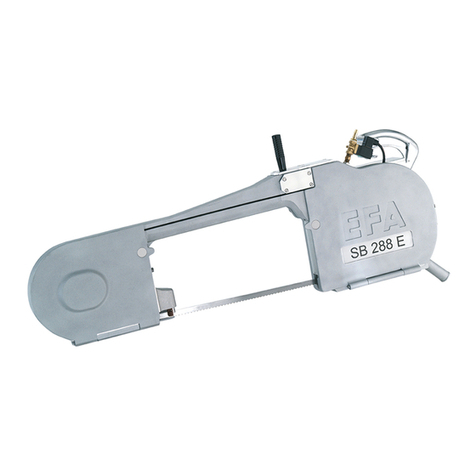
EFA
EFA SB 288 E operating instructions
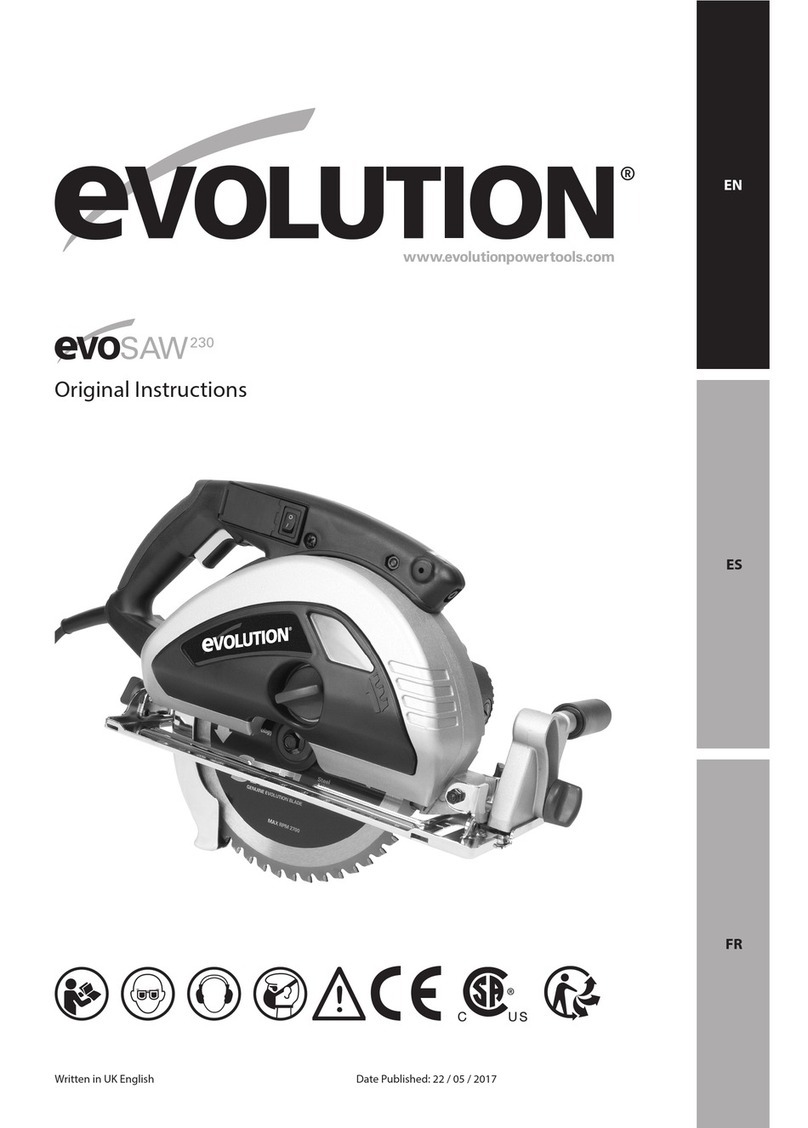
Evolution
Evolution EVOSAW230 Original instructions

Makita
Makita BJR181 instruction manual

Worx
Worx WX523 WorxSaw Safety and operating manual

Black & Decker
Black & Decker Powerful Solutions SMS216 Original instructions
